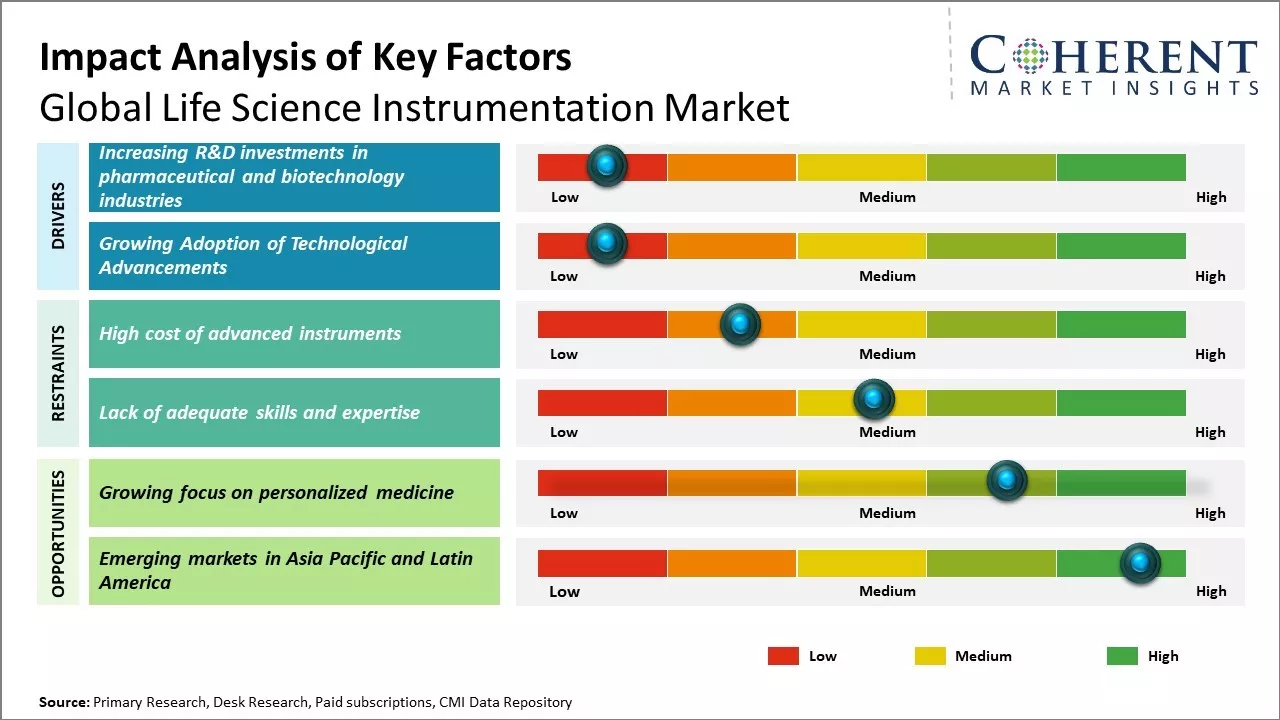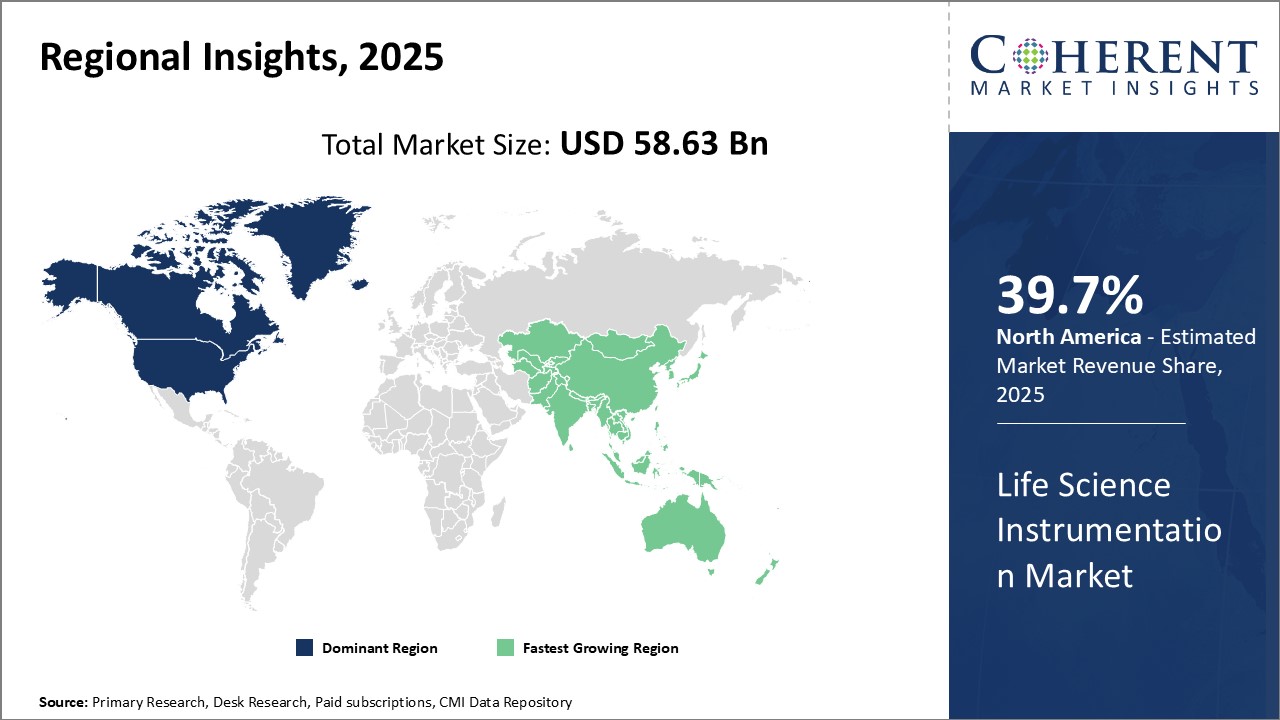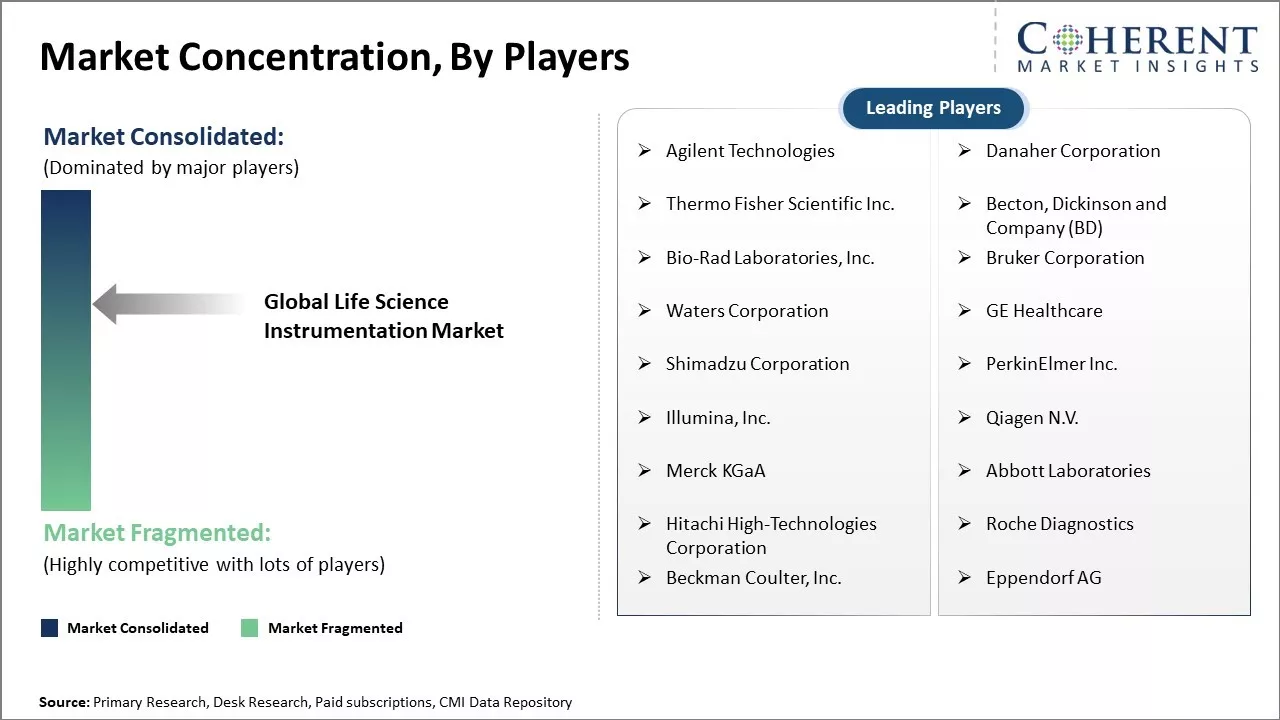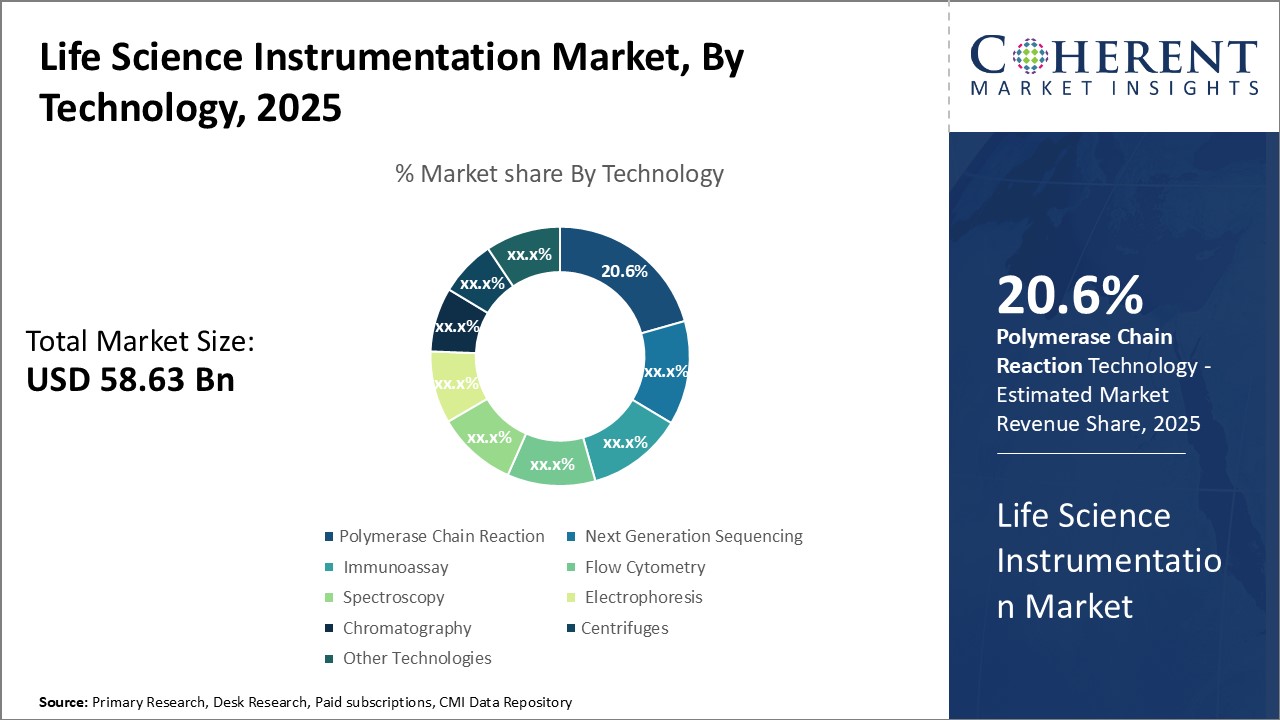Life Science Instrumentation Market Analysis & Forecast: 2025-2032
Life Science Instrumentation Market is estimated to be valued at USD 58.63 Bn in 2025 and is expected to reach USD 90.58 Bn in 2032, exhibiting a compound annual growth rate (CAGR) of 6.4% from 2025 to 2032.

To learn more about this report, Download Free Sample
Key Takeaways
- According to Technology, the Polymerase Chain Reaction (PCR) Category is anticipated to account for the largest share of 20.6% for the Life Science Instrumentation market in 2025.
- According to End User, the Pharmaceutical and Biotechnology Companies Segment is anticipated to hold major share of 35.5% for the Life Science Instrumentation market in 2025.
- According to Application, Clinical & Diagnostic Segment is estimated to hold the largest share of 50.10% in 2025.
- According to region, North America also holds the largest market share of 39.7% for Life Science Instrumentation market growth by 2025.
Market Overview
The global Life Science Instrumentation Market is experiencing robust growth, driven by increasing investments in pharmaceutical R&D, rising prevalence of chronic diseases, and a growing focus on precision medicine. With rising investments in research and development of novel drugs, there is an increasing demand for technologically advanced life science instrumentation. Growing initiatives by governments worldwide to promote precision medicine is another factor boosting the adoption of modern life science instrumentation.
Current Events and Its Impact on the Life Science Instrumentation Market
|
Event |
Description and Impact |
|
Surge in Pharmaceutical R&D Spending and Drug Discovery Initiatives |
|
|
Expansion of Government and Private Funding for Precision Medicine and Genomics |
|
Uncover macros and micros vetted on 75+ parameters: Get instant access to report
Life Science Instrumentation Market Insights, by Technology
In terms of Technology, the Polymerase Chain Reaction (PCR) segment is estimated to hold the highest share of 20.6% in 2025 owing to its widespread usage in genomic research and diagnostics. PCR has transformed molecular biology since its invention in 1983, allowing scientists to amplify specific DNA sequences which has powered key advances like genome sequencing. Ever declining costs of PCR instruments and consumables have also boosted their accessibility.
Moreover, continuous technical improvements like real-time quantitative PCR and digital PCR have expanded the range of PCR applications. Recently, digital PCR has seen increased adoption for detecting minimal residual diseases and rare mutations as it provides more accurate quantification of nucleic acids without standards. Widespread ability to perform multiplex PCR has augmented its utility in genomic and genetic studies involving large numbers of targets.
Life Science Instrumentation Market Insights, by End User
In terms of End User, the Pharmaceutical and Biotechnology Companies segment is estimated to hold the highest share of 35.5% in 2025 owing to their substantive investment in R&D requiring advanced life science tools. Immunoassay technology has emerged as an important segment in this regard due to wide applicability in drug development, discovery and production processes.
Areas such as toxicology testing, therapeutic drug monitoring and assessing bio similarity heavily rely on various immunoassay modalities like enzyme-linked immunosorbent assay (ELISA), radioimmunoassay (RIA), fluorescence immunoassay etc. Complimenting this is the growing need for personalized medicines which has boosted research analyzing genetic and protein biomarkers using immunoassay platforms.
Regional Insights

To learn more about this report, Download Free Sample
North America Life Science Instrumentation Market
North America has long dominated the global life science instrumentation market and is estimated to hold the largest share of 39.2 % in 2025. This can be attributed to the region's heavy investments in biomedical research and presence of top pharmaceutical and biotech companies. The U.S. alone accounts for over 39.7% of the research spending globally and has the highest healthcare expenditure.
Asia Pacific Life Science Instrumentation Market
The Asia Pacific region has emerged as the fastest growing market for life science instrumentation in recent years. Countries like China, Japan, South Korea, India and others are increasingly investing in healthcare and biomedical infrastructure. This has created a surge in demand for advanced life science research tools and analytical equipment within the region. China remains the major growth driver within Asia Pacific as its pharmaceutical industry expands to fulfill the large healthcare needs of its population.
Life Science Instrumentation Market Dominating Countries
U.S Life Science Instrumentation Market
The U.S. remains the largest and most mature market, driven by substantial funding for research, a high concentration of major industry players such as Thermo Fisher Scientific, Danaher, and Agilent Technologies, and advanced healthcare and research infrastructure. This strong ecosystem is further supported by localized manufacturing and supply chains, giving the U.S. a clear industry presence edge.
India Life Science Instrumentation Market
India, meanwhile, is emerging as a major hub for contract research, manufacturing, and the biotechnology sector, with robust government support and rising healthcare investment. The country is witnessing increased adoption of life science instruments, particularly as its pharmaceutical and biotech industries expand and more laboratories and research centers are established.
China Life Science Instrumentation Market
China is the fastest-growing market in the Asia-Pacific region, propelled by rapid expansion of its pharmaceutical and biotechnology sectors, significant investments in healthcare infrastructure, and a large patient population demanding advanced diagnostics and research capabilities.
Market Report Scope
Life Science Instrumentation Market Report Coverage
| Report Coverage | Details | ||
|---|---|---|---|
| Base Year: | 2024 | Market Size in 2025: | USD 58.63 Bn |
| Historical Data for: | 2020 To 2024 | Forecast Period: | 2025 To 2032 |
| Forecast Period 2025 to 2032 CAGR: | 6.4% | 2032 Value Projection: | USD 90.58 Bn |
| Geographies covered: |
|
||
| Segments covered: |
|
||
| Companies covered: |
Agilent Technologies, Danaher Corporation, Thermo Fisher Scientific Inc., Becton, Dickinson and Company (BD), Bio-Rad Laboratories, Inc., Bruker Corporation, Waters Corporation, GE Healthcare, Shimadzu Corporation, PerkinElmer Inc., Illumina, Inc., Qiagen N.V., Merck KGaA, Abbott Laboratories, Hitachi High-Technologies Corporation, Roche Diagnostics, Beckman Coulter, Inc., and Eppendorf AG |
||
| Growth Drivers: |
|
||
| Restraints & Challenges: |
|
||
Uncover macros and micros vetted on 75+ parameters: Get instant access to report
Market Concentration and Competitive Landscape

To learn more about this report, Download Free Sample
Life Science Instrumentation Market: Growth Drivers
- Growth in Pharmaceutical R&D Spending and Discovery Research
One of the major drivers fueling the growth of the global life science instrumentation market is the increase in spending on pharmaceutical R&D by biopharmaceutical companies around the world. A number of leading pharmaceutical companies are heavily investing in developing innovative drugs for various therapeutic areas such as oncology, cardiology and immunology.
Life science instrumentation tools play a crucial role in enabling discovery research activities by providing accurate analysis, virtual screening and high-throughput testing capabilities. With rising investments dedicated for discovery, these tools have become indispensable for target validation, cell line development, assay optimization and screening large compound libraries to identify potential drug candidates.
- Growing Adoption of Technological Advancements
Another important factor contributing to the positive outlook of the life science products market is the rising adoption of new technologies across various application areas. Continuous innovation is taking place in the development of instruments that are more efficient, higher-throughput, miniaturized and capable of multi-modal analysis. Emerging technologies such as automation, machine learning, artificial intelligence, robotics, next-generation sequencing and lab-on-a-chip are tremendously enhancing the capabilities of existing instruments.
Life Science Instrumentation Market: Trends
Growth in Precision and Personalized Medicine
Governments and private sectors worldwide are investing in precision medicine initiatives, driving demand for instruments that support genomics, proteomics, and biomarker research. This trend is boosting the adoption of high-performance analytical and separation technologies, especially in developed markets.
Life Science Instrumentation Market: Key Developments
- May 2025, Revvity, Inc, introduced its new IDS i20 analytical random access platform from EUROIMMUN, enabling full automation of chemiluminescence immunoassays (ChLIA). The IDS i20 platform is a CE marked and FDA listed device that allows laboratories to consolidate multiple specialty tests on a unique single instrument with greater reagent capacity and higher test throughput compared to existing offerings.
- February 2024, Thermo Fisher Scientific Inc., launched the Thermo Scientific™ Dionex™ Inuvion™ Ion Chromatography (IC) system, helping to make ion analysis simpler and more intuitive for labs of all sizes. The new analytical instrument is designed to be easily reconfigurable, providing those who require determination of ionic and small polar compounds with a one stop shop for consistent, reliable ion analysis.
- September 2024, UC San Diego, along with partners Thermo Fisher Scientific and Nikon Instruments, took a critical step forward in that direction with the opening of one of the world’s most pioneering centers for technology across the biological, physical and health sciences.
- December 2024, The Human Proteome Organization (HUPO) 2024 event in Dresden, Germany, offered a vibrant backdrop for Agilent Technologies’ latest product launch the Agilent Infinity III LC Series. This new series has been engineered to meet the evolving needs of researchers, incorporating the InfinityLab Assist Technology, which is designed to enhance the user experience through automating instrument routines, simplifying sample preparation, assisting with maintenance and troubleshooting, and providing context-sensitive help content and solvent management guidance.
April 2024, LICORbio, formerly known as LI-COR Biotechnology, launched two new Odyssey F biomolecular imaging systems. These advanced models promise faster scans, enhanced value, expanded assay support, and maintain the exceptional dynamic range that researchers expect from LICORbio. According to Mike Furtaw, Director of R&D at LICORbio, the Odyssey F represents a significant advancement in their optical imaging technology, offering industry-leading capabilities for speed, versatility in applications, and multiplexing capabilities across both visible and near-infrared spectra
Analyst Opinion
- The life science instrumentation market is estimated to see steady growth over the next few years driven by increasing R&D investments in pharmaceutical and biotechnology industries. Advancing proteomics and genomics research will considerably drive the demand for high-throughput screening instruments and spectroscopy technologies. North America dominated the market in the past owing to presence of major players and focus on precision medicine. However, Asia Pacific is projected to be the fastest growing region owing to expanding biopharma industry and large patient pool in China and India.
- The increasing prevalence of lifestyle diseases and chronic conditions will augment the need for development of novel therapeutics, thereby stimulating sales of analytical and separation instruments. Industry-academia collaboration in life science research also provides an opportunity to introduce new instrument categories.
Life Science Instrumentation Market: Key Companies
Some of the key players in the global Life Science Instrumentation market are Agilent Technologies, Danaher Corporation, Thermo Fisher Scientific Inc., Becton, Dickinson and Company (BD), Bio-Rad Laboratories, Inc., Bruker Corporation, Waters Corporation, GE Healthcare, Shimadzu Corporation, PerkinElmer Inc., Illumina, Inc., Qiagen N.V., Merck KGaA, Abbott Laboratories, Hitachi High-Technologies Corporation, Roche Diagnostics, Beckman Coulter, Inc., and Eppendorf AG
Market Segmentation
- By Technology
- Polymerase Chain Reaction (PCR)
- Next Generation Sequencing
- Immunoassay
- Flow Cytometry
- Spectroscopy
- Electrophoresis
- Chromatography
- Centrifuges
- Other Technologies
- By End User
- Hospitals and Diagnostic Centers
- Pharmaceutical and Biotechnology Companies
- Contract Research Organization (CRO)
- Academia and Research Institutes
- By Application
- Clinical & Diagnostic
- Research
- Other
- Region
- North America
- U.S.
- Canada
- Latin America
- Brazil
- Argentina
- Mexico
- Rest of Latin America
- Europe
- Germany
- U.K.
- Spain
- France
- Italy
- Russia
- Rest of Europe
- Asia Pacific
- China
- India
- Japan
- Australia
- South Korea
- ASEAN
- Rest of Asia Pacific
- Middle East
- GCC Countries
- Israel
- Rest of Middle East
- Africa
- South Africa
- North Africa
- Central Africa
- North America
- Company Profiles
- Agilent Technologies
- Danaher Corporation
- Thermo Fisher Scientific Inc.
- Becton, Dickinson and Company (BD)
- Bio-Rad Laboratories, Inc.
- Bruker Corporation
- Waters Corporation
- GE Healthcare
- Shimadzu Corporation
- PerkinElmer Inc.
- Illumina, Inc.
- Qiagen N.V.
- Merck KGaA
- Abbott Laboratories
- Hitachi High-Technologies Corporation
- Roche Diagnostics
- Beckman Coulter, Inc.
- Eppendorf AG
Sources
Primary Research interviews
- R&D Heads at Thermo Fisher Scientific, Agilent Technologies, PerkinElmer
- Product Managers at Bio-Rad Laboratories, Bruker Corporation, Danaher Corporation
- Lab Managers at academic research institutions
- Procurement Leads at CROs and CMOs
- Regulatory Affairs Professionals in biopharma companies
Databases
- NIH RePORTER (US-funded research grants by equipment usage)
- OECD iLibrary – R&D investment and lab infrastructure metrics
Magazines
- Lab Manager Magazine
- Genetic Engineering & Biotechnology News (GEN)
- SelectScience
- Technology Networks – Analytical Science
- The Analytical Scientist
- Labcompare
- BioSpectrum Asia
Journals
- Analytical Chemistry (ACS Publications)
- Journal of Chromatography A & B (Elsevier)
- Lab on a Chip (Royal Society of Chemistry)
- Nature Methods
- Trends in Analytical Chemistry
- Journal of Proteome Research
- Biosensors and Bioelectronics
Newspapers
- The Wall Street Journal – HealthTech and M&A coverage
- The Financial Times – Biotech and science industry trends
- The Economic Times (India) – Domestic instrumentation players
- Nikkei Asia – APAC market activity in scientific tools
Associations
- American Association for Clinical Chemistry (AACC)
- American Chemical Society (ACS)
- International Society for Analytical Cytology (ISAC)
- European Molecular Biology Laboratory (EMBL)
- AOAC International (for method validation standards)
- International Society for Pharmaceutical Engineering (ISPE)
- US FDA – Center for Devices and Radiological Health (CDRH)
- National Institute of Standards and Technology (NIST)
Proprietary Elements
- CMI Data Analytics Tool, Proprietary CMI Existing Repository of information for last 8 years
*Definition: The Global Life Science Instrumentation Market consists of instruments used across various life science industries like biotechnology, pharmaceutical, diagnostic and many more. This includes analytical instruments like chromatography, spectroscopy, PCR and sequencing equipment used for purification, identification and analysis. It also contains lab equipment like centrifuges, incubators, sterilizers used majorly in research activities. The Global Life Science Instrumentation Market aims to advance life science research by providing innovative, high quality and precise analytical tools and lab equipment enabling faster development of drugs, diagnostics and other applications.
Share
Share
About Author
Komal Dighe is a Management Consultant with over 8 years of experience in market research and consulting. She excels in managing and delivering high-quality insights and solutions in Health-tech Consulting reports. Her expertise encompasses conducting both primary and secondary research, effectively addressing client requirements, and excelling in market estimation and forecast. Her comprehensive approach ensures that clients receive thorough and accurate analyses, enabling them to make informed decisions and capitalize on market opportunities.
Missing comfort of reading report in your local language? Find your preferred language :
Transform your Strategy with Exclusive Trending Reports :
Frequently Asked Questions
EXISTING CLIENTELE
Joining thousands of companies around the world committed to making the Excellent Business Solutions.
View All Our Clients

